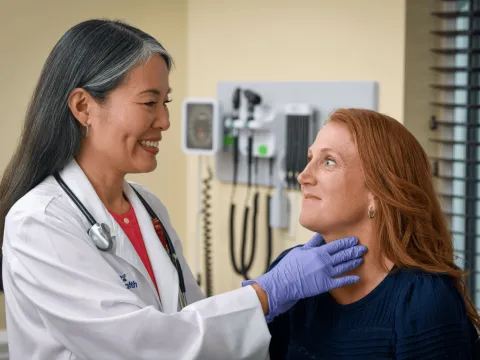- AdventHealth

Choose the health content that’s right for you, and get it delivered right in your inbox.
If you’re wondering what a DOT physical is for, you might have been asked to get one for your job. A DOT physical is like a regular physical exam but has specific components and a unique purpose.
Read on to learn about the DOT exam and find out where to get the whole-person health care you deserve.
What Is a DOT Physical Test?
DOT stands for Department of Transportation — so a DOT physical is a Department of Transportation physical exam. In the United States, almost anyone who operates a commercial motor vehicle must pass a DOT physical. It’s a part of standard occupational health and safety. The purpose of this is to help avoid workplace injuries and ensure the driver’s safety along with the safety of others on the road or at the job site.
A DOT exam is a series of tests that gather information about your physical, mental and cognitive abilities. After your physical, your doctor will review the information and determine whether you can safely operate a commercial motor vehicle. Passing your DOT exam can help you get jobs working in public transportation, operating forklifts and more.
Who Needs a DOT Physical?
It’s important to understand what a DOT physical is for in the workplace. Any profession in the US that requires you to drive a commercial vehicle will require a DOT physical. The following job functions require a DOT physical for you to perform tasks or earn certifications:
- CDL (commercial driver’s license)
- Hazardous material transportation
- Interstate driving: when the vehicle weighs 10,000+ pounds
- Multi-passenger transportation: 16 or more people
- Paid multi-passenger transportation: eight or more people
In short, any job or volunteer service that requires you to transport a certain number of people or specific hazardous materials will require a DOT physical.
How Often do You Need to Pass a DOT Physical?
It’s important to know how long DOT physicals are valid. If your physician deems you fit to drive, and you’re in good general health, you’ll likely only need to pass a DOT physical once every two years.
However, certain medical conditions may require you to pass a physical more frequently. For example, chronic conditions like diabetes and high blood pressure can pose more risks to you and others while you’re driving. For this reason, drivers with these types of health conditions will likely need to pass a DOT physical annually or more often. This shortened approval period ensures that a doctor or other qualified medical professional can keep an eye on your physical and mental health.
For those with health conditions, frequent evaluations help keep the roadways safe. After all, what is the purpose of a DOT physical? It’s to ensure your safety and the safety of other drivers on the road.
Where to Get a DOT Physical
You can get a DOT physical exam from any health care provider licensed by the Federal Motor Carrier Safety Administration. Your health care provider must also have one of the following credentials:
- Doctor of Osteopathy (DO)
- Medical Doctor (MD)
- Nurse Practitioner (NP)
- Physician Assistant (PA)
- In some cases, advanced practice registered nurses (APRNs) can perform DOT physicals
At AdventHealth Centra Care, we offer qualified DOT physical exams at your convenience. Our experienced health care providers are knowledgeable and patient, ready to provide you with the care you deserve. We’re here to help you build and maintain your career in transportation with timely DOT physicals.
We encourage you to visit our urgent care centers for your next DOT exam. You can reserve an appointment online or walk into one of our Centra Care locations near you.
Components of a DOT Physical
While a DOT physical is similar to a standard physical exam, you can expect more in-depth assessments, such as vision and hearing evaluations. The ultimate goal is the same as any other physical — to ensure you’re in good health and can safely perform necessary tasks and activities for your profession.
It’s helpful to be prepared going into your DOT physical. What is a DOT physical, and what does it consist of? During your physical assessments, you can expect:
- Cardiovascular and respiratory examinations
- Medical history review
- Musculoskeletal and neurological evaluations
- Urinalysis
- Vision and hearing tests
These are all important parts of the DOT exam, and they all serve a unique purpose.
Cardiovascular and Respiratory Exams
Think of these as your basic vital measurements. The doctor will take your pulse and blood pressure and listen to your breathing. They will also record your height and weight.
If you have a preexisting heart condition, you may need a letter from a cardiologist clearing you to drive commercial vehicles. You’ll also need to turn in documentation of recent cardiac test results. This usually applies to people with heart murmurs and other cardiac conditions.
Medical History Review
A DOT physical is a comprehensive review of how healthy and fit you are to drive a large vehicle. Commercial vehicles come with additional risks, so it makes sense that your DOT physical requires a medical history review.
A physician or other qualified medical professional will review your medical history. This aims to see what your physical, mental and emotional health looked like in the past. Your past health events and conditions can influence your current physical and psychological state, so we want to ensure you’re in the healthiest state you can be.
Before starting your physical exam, you will need to fill out an assessment form. This form will ask about previous health conditions, surgeries, hospitalizations and disabilities.
Think of this assessment form as a pre-screening for potential problems. The doctor uses it to determine which areas to focus on and what follow-up questions to ask during your exam.
It’s important for you to answer any written or verbal questions with complete honesty. Doing this allows the doctor to have your most accurate health information to provide you with the best quality of care. If you fabricate answers, you could risk your safety and the well-being of others on the road.
Musculoskeletal and Neurological Evaluations
What is a DOT physical’s purpose for your muscular and skeletal systems? Musculoskeletal and neurological tests aim to prevent danger on the road. They ensure you can use your arm and leg muscles to drive and maneuver properly.
Each of these screenings is also designed to catch potential dangers like seizures and dizziness, which can affect how you drive.
The doctor will test your neurological health by observing your reflexes, balance and gait (walking). This is to ensure you don’t have any dizziness or neurological problems with coordination. The doctor will also examine you for any hernias or genital abnormalities. They also can observe any musculoskeletal problems in your limbs or midsection to screen for potential safety risks.
Urinalysis
What will a DOT physical find through urinalysis? A urinalysis can detect abnormalities or traces of blood, proteins, ketones and glucose, which may indicate more serious health concerns.
You’ll need to urinate in a cup to check for underlying health problems. This urinalysis covers things like kidney problems, diabetes and more. While this isn’t used to screen for drugs or alcohol, it’s important to know that before accepting employment in these fields, you’ll have to pass a drug and alcohol test.
Vision and Hearing Tests
What is a DOT physical vision and hearing test for? It ensures that commercial vehicle drivers can see and hear things adequately.
When driving large or multi-passenger commercial vehicles, you need to see and hear the world around you accurately. Your vision and hearing will inform you of potential risks and help you make safe driving decisions while on the road. For this reason, DOT physical exams include vision and hearing assessments.
What is a DOT physical’s list of passing criteria? Some baseline vision and hearing requirements include:
- Ability to hear a “forced whisper” from 5 feet away with each ear
- Color recognition for traffic lights and signs
- Field of vision of at least 70 degrees in each eye
- 20/40 vision or better in each eye (with or without glasses)
It’s important to note that you can still pass the vision tests if you need corrective eyewear. Your medical card may specify that you’re only cleared to drive commercial vehicles while wearing glasses or contacts.
How To Prepare for a DOT Physical
Now you know what a DOT physical is and what it consists of. But it’s equally important to understand what you need to do to prepare for this examination to ensure the most accurate and timely results.
Documentation is extremely important when it comes to passing your DOT physical. Thoroughly document any minor or major health conditions, surgeries, medications, disabilities and treatment plans.
Remember that these exams keep you, your passengers and other motorists as safe as possible. There are documents and other necessary steps you’ll need to take for a DOT physical.
Address Health Problems in Advance
If you have chronic health conditions, it’s essential that you work with your health care provider to ensure optimal health. Having a primary care physician is key to managing lifelong health conditions.
What is a DOT physical going to catch? It can bring up issues of high blood pressure, diabetes, neurological problems and more. It’s important to address these conditions to ensure you get the whole-person health care you deserve.
Before you go in for a DOT physical, speak with your family or primary care doctor. Usually, a combination of medication and lifestyle changes will improve chronic health conditions, allowing you to pass your DOT physical exam.
Collect Your Paperwork and Medical Documents
It could be helpful to create a folder for your DOT documentation. A DOT physical folder can help you present all your medical information in one place.
Print out all necessary medical records, paperwork and treatment documentation that encompass your recent medical history. It’s important to know that as a patient, you have the right to request your health records from any hospital or doctor’s office you’ve visited.
If you need a letter from a specialist to signify that your underlying health conditions are being successfully treated, you’ll need a signed paper letter to put in your folder. Have the specialist include their practice address, full name and phone number on the paper so the letter can be verified.
You should also include an updated medication list with the relevant dosages and frequencies.
As a rule of thumb, include these documents in your DOT folder:
- Blood test results
- Cardiac test results
- CPAP report
- Eyeglass prescription information
- Hearing aid prescription information
- Insulin-treated diabetes mellitus assessment form
- Letters from specialists treating major health conditions
- Neurological test results
- Photo ID
- Physician and specialist list with phone numbers and addresses
- Skilled performance examination results (for loss of limbs, etc.)
- Sleep test results
- Surgery list with dates
- Updated medication list
Only the documents that directly apply to you should be in your folder.
Centra Care Offers Qualified DOT Physicals for Compliance and Safety
When asking what a DOT physical is, it’s important to remember its primary purpose — to keep you and others around you safe. Be honest and accurate during your exam.
When you’re behind the wheel of a motor vehicle, avoiding danger is the most valuable thing you can do. Our health care providers encourage safe transportation and help prevent roadway danger by performing qualified DOT physicals.
It’s important not to skip this regulatory exam for any reason. There are good reasons that the Department of Transportation requires DOT physicals for commercial vehicle operation. By getting your routine DOT physical exams, you do your part in maintaining roadway safety and legal compliance.
We Help Keep Your Employees Safe and Well
We know how valuable your team members are to you and your business. With more than 40 years of experience, our occupational health services at AdventHealth Centra Care will provide your employees the expert, experienced care they deserve to keep working safely, efficiently and well.
Find out how AdventHealth Centra Care’s Occupational Medicine program can help your employees get their DOT exam as fast and efficiently as possible. Visit us here.





